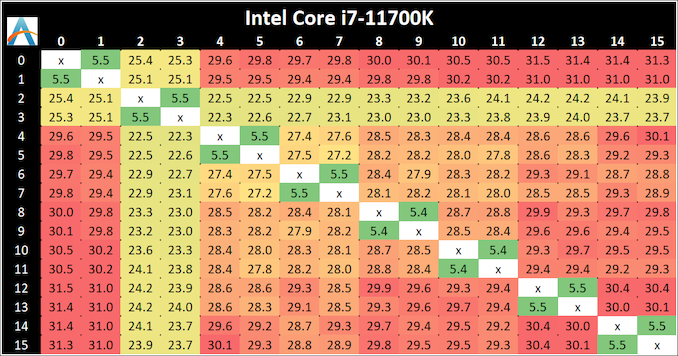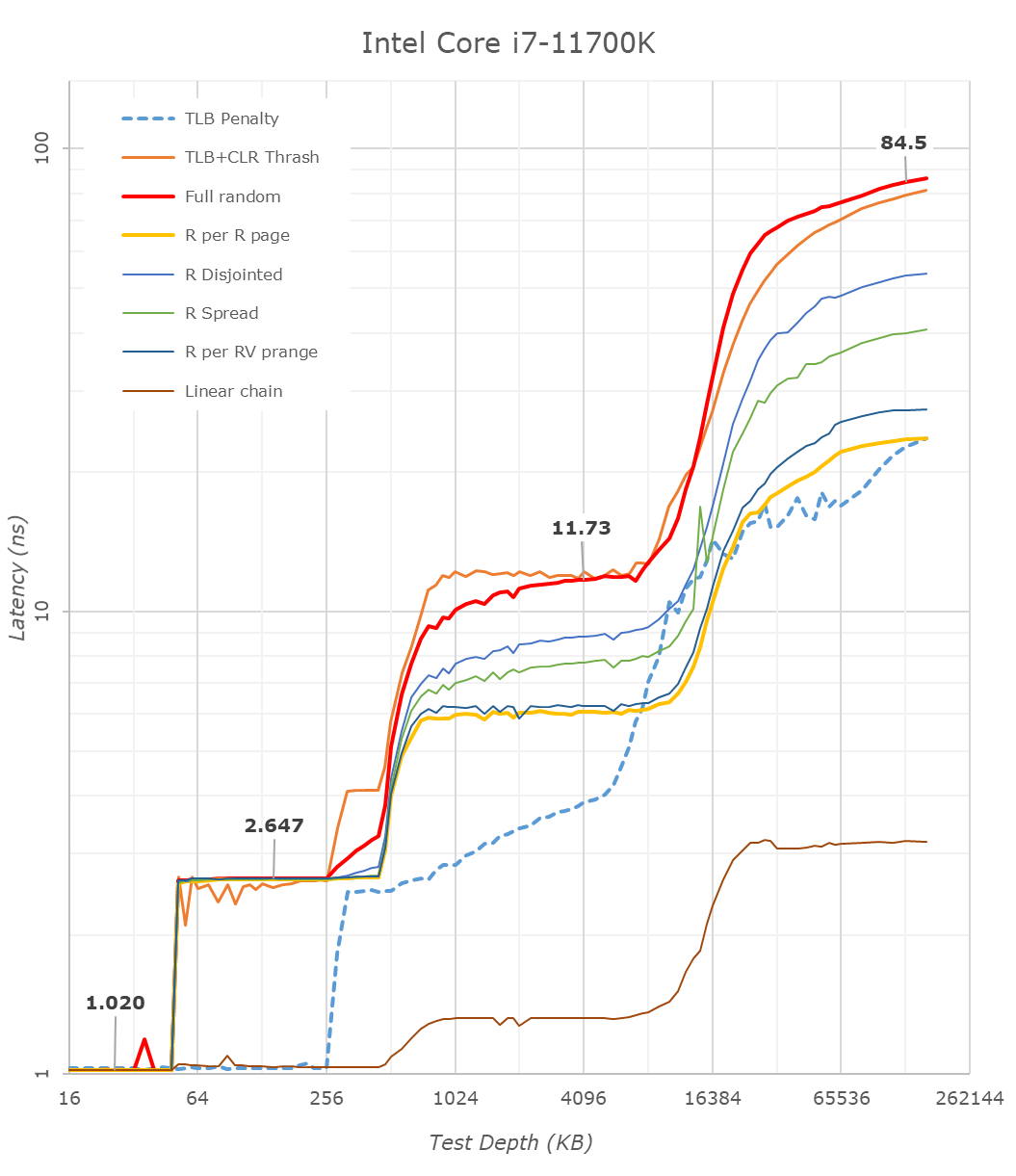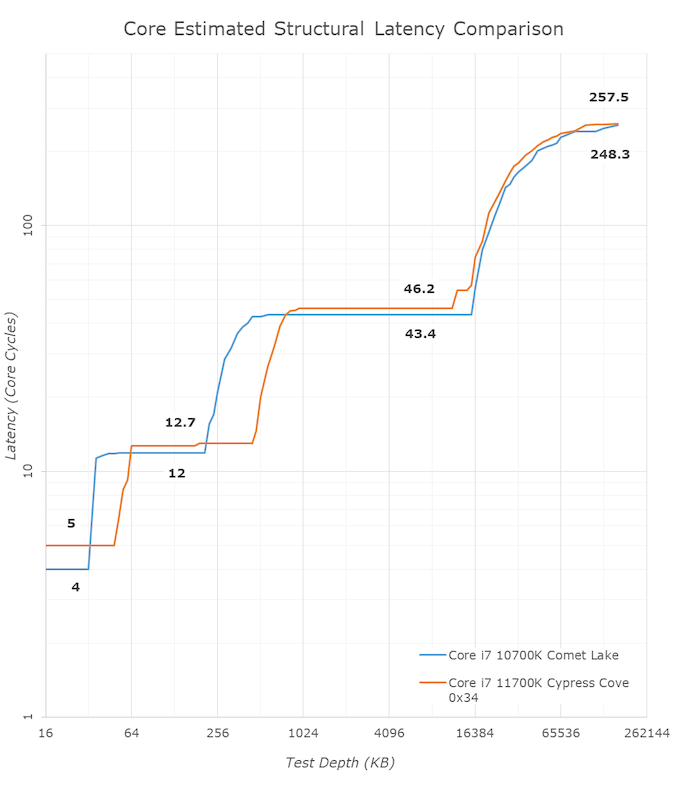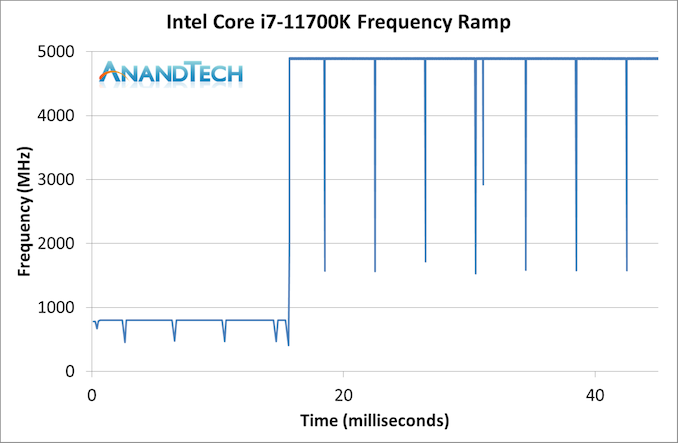Intel Core i7-11700K Review: Blasting Off with Rocket Lake
by Dr. Ian Cutress on March 5, 2021 4:30 PM EST- Posted in
- CPUs
- Intel
- 14nm
- Xe-LP
- Rocket Lake
- Cypress Cove
- i7-11700K
CPU Tests: Microbenchmarks
Core-to-Core Latency
As the core count of modern CPUs is growing, we are reaching a time when the time to access each core from a different core is no longer a constant. Even before the advent of heterogeneous SoC designs, processors built on large rings or meshes can have different latencies to access the nearest core compared to the furthest core. This rings true especially in multi-socket server environments.
But modern CPUs, even desktop and consumer CPUs, can have variable access latency to get to another core. For example, in the first generation Threadripper CPUs, we had four chips on the package, each with 8 threads, and each with a different core-to-core latency depending on if it was on-die or off-die. This gets more complex with products like Lakefield, which has two different communication buses depending on which core is talking to which.
If you are a regular reader of AnandTech’s CPU reviews, you will recognize our Core-to-Core latency test. It’s a great way to show exactly how groups of cores are laid out on the silicon. This is a custom in-house test built by Andrei, and we know there are competing tests out there, but we feel ours is the most accurate to how quick an access between two cores can happen.
The core-to-core numbers are interesting, being worse (higher) than the previous generation across the board. Here we are seeing, mostly, 28-30 nanoseconds, compared to 18-24 nanoseconds with the 10700K. This is part of the L3 latency regression, as shown in our next tests.
One pair of threads here are very fast to access all cores, some 5 ns faster than any others, which again makes the layout more puzzling.
Update 1: With microcode 0x34, we saw no update to the core-to-core latencies.
Cache-to-DRAM Latency
This is another in-house test built by Andrei, which showcases the access latency at all the points in the cache hierarchy for a single core. We start at 2 KiB, and probe the latency all the way through to 256 MB, which for most CPUs sits inside the DRAM (before you start saying 64-core TR has 256 MB of L3, it’s only 16 MB per core, so at 20 MB you are in DRAM).
Part of this test helps us understand the range of latencies for accessing a given level of cache, but also the transition between the cache levels gives insight into how different parts of the cache microarchitecture work, such as TLBs. As CPU microarchitects look at interesting and novel ways to design caches upon caches inside caches, this basic test proves to be very valuable.
Looking at the rough graph of the 11700K and the general boundaries of the cache hierarchies, we again see the changes of the microarchitecture that had first debuted in Intel’s Sunny Cove cores, such as the move from an L1D cache from 32KB to 48KB, as well as the doubling of the L2 cache from 256KB to 512KB.
The L3 cache on these parts look to be unchanged from a capacity perspective, featuring the same 16MB which is shared amongst the 8 cores of the chip.
On the DRAM side of things, we’re not seeing much change, albeit there is a small 2.1ns generational regression at the full random 128MB measurement point. We’re using identical RAM sticks at the same timings between the measurements here.
It’s to be noted that these slight regressions are also found across the cache hierarchies, with the new CPU, although it’s clocked slightly higher here, shows worse absolute latency than its predecessor, it’s also to be noted that AMD’s newest Zen3 based designs showcase also lower latency across the board.
With the new graph of the Core i7-11700K with microcode 0x34, the same cache structures are observed, however we are seeing better performance with L3.
The L1 cache structure is the same, and the L2 is of a similar latency. In our previous test, the L3 latency was 50.9 cycles, but with the new microcode is now at 45.1 cycles, and is now more in line with the L3 cache on Comet Lake.
Out at DRAM, our 128 MB point reduced from 82.4 nanoseconds to 72.8 nanoseconds, which is a 12% reduction, but not the +40% reduction that other media outlets are reporting as we feel our tools are more accurate. Similarly, for DRAM bandwidth, we are seeing a +12% memory bandwidth increase between 0x2C and 0x34, not the +50% bandwidth others are claiming. (BIOS 0x1B however, was significantly lower than this, resulting in a +50% bandwidth increase from 0x1B to 0x34.)
In the previous edition of our article, we questioned the previous L3 cycle being a larger than estimated regression. With the updated microcode, the smaller difference is still a regression, but more in line with our expectations. We are waiting to hear back from Intel what differences in the microcode encouraged this change.
Frequency Ramping
Both AMD and Intel over the past few years have introduced features to their processors that speed up the time from when a CPU moves from idle into a high powered state. The effect of this means that users can get peak performance quicker, but the biggest knock-on effect for this is with battery life in mobile devices, especially if a system can turbo up quick and turbo down quick, ensuring that it stays in the lowest and most efficient power state for as long as possible.
Intel’s technology is called SpeedShift, although SpeedShift was not enabled until Skylake.
One of the issues though with this technology is that sometimes the adjustments in frequency can be so fast, software cannot detect them. If the frequency is changing on the order of microseconds, but your software is only probing frequency in milliseconds (or seconds), then quick changes will be missed. Not only that, as an observer probing the frequency, you could be affecting the actual turbo performance. When the CPU is changing frequency, it essentially has to pause all compute while it aligns the frequency rate of the whole core.
We wrote an extensive review analysis piece on this, called ‘Reaching for Turbo: Aligning Perception with AMD’s Frequency Metrics’, due to an issue where users were not observing the peak turbo speeds for AMD’s processors.
We got around the issue by making the frequency probing the workload causing the turbo. The software is able to detect frequency adjustments on a microsecond scale, so we can see how well a system can get to those boost frequencies. Our Frequency Ramp tool has already been in use in a number of reviews.
Our ramp test shows a jump straight from 800 MHz up to 4900 MHz in around 17 milliseconds, or a frame at 60 Hz.














541 Comments
View All Comments
Fulljack - Saturday, March 6, 2021 - link
I guess to his understanding either this CPU are engineering sample or/and that using beta BIOS, microcode, and firmware so this is not "full retail".romrunning - Saturday, March 6, 2021 - link
@terroradagio - "Using a CPU that wasn't supposed to be sold is a total backdoor and deceptive way of handling this. "You're really not making sense. They bought a retail boxed CPU from a retailer; they didn't test an engineering sample. The same box would have ended up in someone's hands when purchased by them, and the retailer's stock of RKL CPUs will also be sold to customers. To say Anandtech used "a CPU that wasn't supposed to be sold" is a complete lie. A retailer sells products; they don't stock products just for themselves.
If you're going to argue something, at least argue something with more validity.
CiccioB - Friday, March 5, 2021 - link
Not that I want to defend Intel, but to you and all others that have difficulties at understanding numbers (you just look at them and report the value without thinking about their meaning):The 290W power consumption was achieved by using AVX-512 instructions. In the test that uses them Intel is <b>6 times</b> faster at double the power consumption than AMD CPU.
So under the point of perf/W with AVX-512 compatible workload (responsible for those high power consumption) there no doubts that Intel is the winner with a very large margin.
So better to concentrate on other power consumption terms to make this chip appear the fail it actually is with respect to the new architecture that does not really improve on almost anything.
lmcd - Friday, March 5, 2021 - link
Frankly I think some of us (at least, I) got confused by the revision of CPU architecture going into this design. Tiger Lake's Cove version might've changed the outcome, even if the timeline didn't work. Maybe would've been way too big though.CiccioB - Friday, March 5, 2021 - link
I'm not a CPU architectural engineer so I just can guess that this compromise of architecture and process is the best Intel could come up also taking into account production limitations.Probably it is not the best thing Intel could have done in absolute terms, but it for sure will be available at big quantities (unlike "super fast advance mega efficient hyper many core" AMD CPUs, and worse APUs) and that could be enough to fill the market until Alder lake is presented.
You know, this generation is just a fill gap as it is not a 10nm generation and can't get all those Cove's improvements on the now obsolete (but still high performing and delivering) 14nm process.
Cooe - Saturday, March 6, 2021 - link
Zen 3 in the form of the directly competing R7 5800X is widely available at MSRP. How many times must you be told this before it gets into your thick ass skull??? O_oSpunjji - Saturday, March 6, 2021 - link
The complaint here is that 290W exceeds the capabilities of the vast majority of air coolers. The Perf/W you get is irrelevant if you melt your CPU.In directly comparable tests where the same work.is being done, Intel's Perf/W is still roughly 50% worse than the 5800X.
TheinsanegamerN - Friday, March 5, 2021 - link
Cant handle Intel dumping arse all over the bed eh?terroradagio - Friday, March 5, 2021 - link
Why are you guys making this an Intel vs AMD thing, when I am not? Get a life. This is about professionalism. Go take your AMD worshipping and Intel hating elsewhere.Makaveli - Friday, March 5, 2021 - link
And who are you to question Anandtech professionalism you sound like a butt hurt fan boy. Quit the crying and just move on.